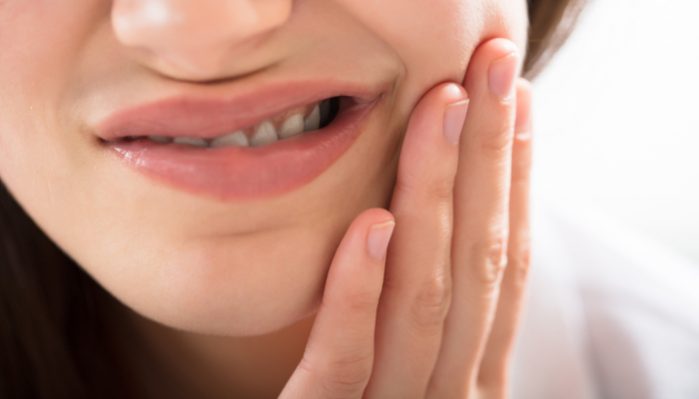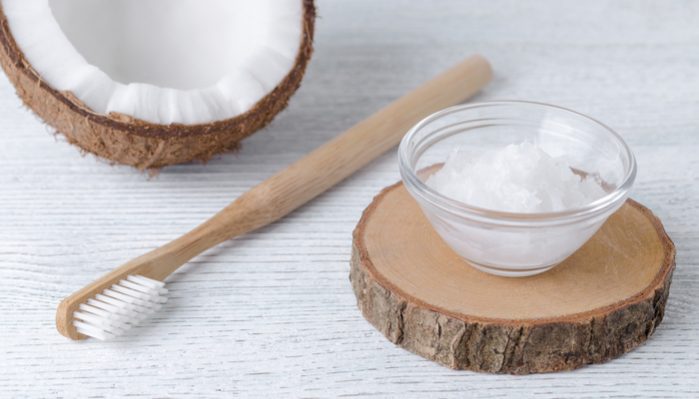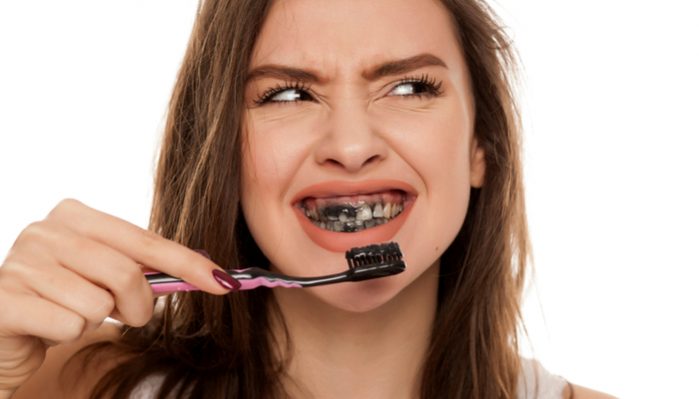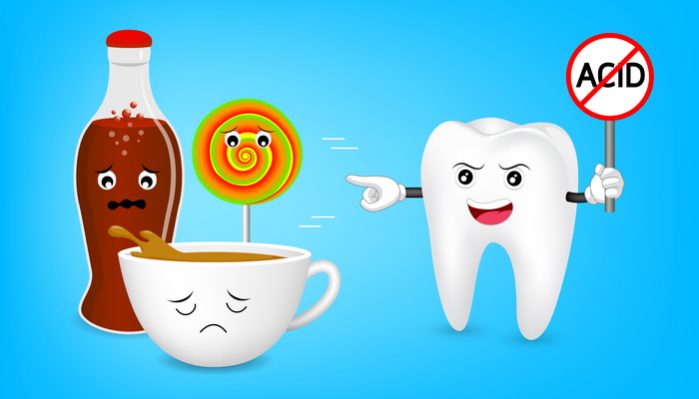Our teeth are one of the first things people notice. When creating a first impression, or simply just smiling, most of are self-conscious about our teeth being yellow or stained. Consequently, this can take a hit on our confidence. We are obsessed with having white teeth, hence the growing number of people using white strips.
Teeth whitening has become a huge business. In 2015, Americans alone spent over $11 billion on teeth whitening, including over $1.4 billion on at-home whitening products. In dentist offices, bleaching is the most requested procedure among patients ages 40 to 60.

However, conventional teeth whitening methods may not be safe or entirely effective. In addition to tooth sensitivity, dentists report seeing side effects that include:
- Painful internal damage that can lead to a root canal
- Gum irritation
- Bluish enamel
- Uneven whiteness
So, What’s The Best Way To Whiten Teeth Naturally?
We have 9 solutions to whiten teeth, that are both natural and safe. It’s important to note that these remedies will not whiten your teeth overnight, but if you stick to a good oral hygiene routine, you can be sure to notice a difference in the appearance of your teeth over a couple of weeks.
1. Brush with Baking Soda
Baking soda has natural whitening properties. It’s a mild abrasive that can help scrub away surface stains on teeth. Additionally, baking soda creates an alkaline environment in your mouth, which prevents certain bacteria from growing. [1]
Scientist have not yet proven that brushing with plain baking soda will whiten your teeth, but several studies show that toothpaste with baking soda has a significant whitening effect. [1]
Tip: mix 1 teaspoon of baking soda with 2 teaspoons of water and brush your teeth with the paste. You can do this a few times per week. Not every day as it can wear away tooth enamel. [1]
2. Hydrogen Peroxide
Hydrogen peroxide is a natural bleaching agent that also kills bacteria in your mouth. Many commercial whitening products contain hydrogen peroxide. Several studies have analyzed commercial toothpaste containing peroxide. [1]
- One study found that a toothpaste containing baking soda and 1% hydrogen peroxide led to significantly whiter teeth. [1]
- Another study found that brushing with commercial toothpaste containing baking soda and peroxide twice per day led to 62% whiter teeth in six weeks. [1]
Tip: Use hydrogen peroxide by mixing it with baking soda to make a paste. Combine 2 teaspoons of hydrogen peroxide with 1 teaspoon of baking soda and gently brush your teeth with the mixture. Again, like baking soda, limit the use of this paste to a few times per week, as overuse can erode your tooth enamel. [1] Also, if there are kids in the home, be sure to keep hydrogen peroxide tucked away and out of reach.
3. Oil Pulling

Oil pulling is a traditional Indian folk remedy meant to improve oral hygiene and remove toxins from the body. The practice involves swishing oil around in your mouth to remove bacteria, which can turn into plaque and cause your teeth to look yellow. [1]
Coconut oil is a popular choice because it has a pleasant taste and offers many additional health benefits. A few studies have shown that daily oil pulling reduces bacteria in the mouth, along with plaque and gingivitis. [1]
Tip: put 1 tablespoon of coconut oil in your mouth and push and pull the oil through your teeth. Continue the oil pulling for a full 15–20 minutes if you can. [1]
4. Activated Charcoal

The activated charcoal’s pores bind with rough parts of teeth, usually surface stains and plaque, making it easier to remove the yellowing substances. Once the charcoal has been given enough time to stick to your teeth, it can be removed, and when it is, the mineral takes the plaque, food particles, and surface stains with it. [3]
Relative Dentin Abrasivity (RDA) is a guide to measure abrasiveness for all FDA approved dental products, and the FDA recommends a score of 200 or below. Activated charcoal powder scores about a 70 to 90 on the RDA scale while most whitening toothpaste score between 100 to 200 RDA. Always check the abrasiveness of activated charcoal toothpaste.
Tip: Start by adding water to form a paste. Then apply the paste directly onto your teeth, leave the activated charcoal paste on your teeth for three minutes to ensure that it has had enough time to bind with surface stains on your teeth, then thoroughly rinse your mouth out several times before brushing your teeth clean. AC can damage the enamel of your teeth so please use in moderation. [3]
This method of teeth whitening has quickly become a growing frenzy online. There are many videos on social media with people experimenting with AC, some questioning how effective it really is.
Check out this video to see for yourself!
5. Turmeric
Turmeric, which is used for a variety of home remedies, has become a very popular natural teeth whitener. Sounds odd but it actually works. Studies show that turmeric brings oral health benefits that other natural remedies and over-the-counter remedies don’t. [11]
Trying turmeric as a teeth whitener is simple and can be done in a few ways. It’s recommended that you use it no more than once per day. Keep in mind: This treatment will turn your toothbrush bristles yellow. [11]
Tip: Pour out a little bit of high-quality pure turmeric powder. Wet the bristles of your toothbrush and dip them into the powder. Brush your teeth like you usually would, spreading the turmeric powder on your gums and teeth. Instead of rinsing right away, let the powder sit on your teeth for at least five minutes. Next, rinse out your mouth thoroughly with water. Then, brush your teeth again with regular toothpaste. [11]
6. Strawberries (and baking soda)
Whitening your teeth with a strawberry and baking soda mixture is a natural remedy that is gaining notoriety. Advocates of this method claim that the malic acid found in strawberries will remove discoloration on your teeth, while the baking soda will buff away stains. [1]
However, this remedy has not been completely backed up by science. While strawberries may help exfoliate your teeth and make them appear whiter, they are unlikely to penetrate the stains on your teeth. [1]
A recent study found that strawberry and baking soda mixture produced very little color change in teeth, compared to commercial whitening products. If you decide to give this method a try, limit its use to a few times per week. [1]
Tip: smash up a fresh strawberry, combine it with baking soda and brush the mixture on your teeth. Make sure to floss away tiny seeds!
7. Raw Fibrous Fruits and Veggies
- Broccoli – High-fiber, coarse foods act as scrubbing agents for teeth. Toss them on your salad for a quick, natural mid-day brush. [9]
- Apples – That loud crunch you hear when you bite into an apple is actually helping to strengthen your gums, and the fruit’s high water content increases saliva production. That extra spit washes away bacteria that can lead to discoloration. [9]
- Celery and Carrots – The same high water content that makes these veggies great for your health also whitens your teeth by washing away food debris and strengthening gums. [9]
- Pears – The flesh of this delicious fruit helps neutralize the acid in your mouth that causes decay. [9]
8. Limit Acidic Foods

The acid in the foods cause tooth enamel to wear away, and teeth can become discolored. When tooth enamel weakens in this way, demineralization has started to occur – leaving your teeth’s dentin exposed and prone to sensitivity. [8]
Brushing after a meal is generally a good idea, but avoid doing so right after consuming acidic foods. Acid softens your enamel, and brushing too soon will only speed up tooth wear before the enamel has time to settle again. [8]
Acidic Foods You Should Try To Limit: [8]
- Ultra-processed foods, such as frozen dinners, store-bought cakes and sodas
- Alcohol
- Milk
- Caffeinated drinks
- Processed cereals
- Artificial sweeteners
- Pasta
- Rice
- Bread
- Cold cuts
9. Minimize Pigmented Foods
Highly pigmented foods can take a dingy toll on our pearly whites. However, this can be a tough one, as most of these pigmented types of foods can actually be healthy for you. Luckily there are steps you can take when eating them:
- Pasta Sauce – Because of their acidity, bright red hue and tendency to cling to the teeth, the tomatoes in pasta sauce can leave your teeth vulnerable to staining. [4]
Tip: Dine on some dark green veggies, such as broccoli, kale, and spinach, beforehand to create a protective film over the teeth. The film will ward off tomatoes’ staining effect. - Balsamic Vinegar – This is a healthy salad dressing, but it can also darken your teeth. It sticks to your teeth, which can lead to staining if it’s not quickly brushed away. You don’t have to give up on this light salad dressing. [4]
Tip: Whenever you have a salad with balsamic vinegar, be sure to include crunchy lettuce; chewing the lettuce will help clean the staining balsamic vinegar from your teeth as you eat. - Berries – Berries provide many health benefits, such as antioxidants, but they also have the potential to stain your teeth. The deep hue in blueberries, cranberries, raspberries, and blackberries, in particular, can cause staining, regardless of whether they are eaten whole, drunk as juice or processed as jam. Don’t let them linger in your mouth for too long, and drink water to combat their staining effect. [4]
Tip: Finish with a glass of milk or a serving of hard cheese, both of which neutralize the acid and strengthen teeth.
Final Note
If you want whiter teeth, but don’t want to use the conventional whitening methods that can harm you, then these 9 solutions are worth giving a try.
On top of that, if you stick to a proper oral hygiene routine: regular brushing, flossing, and scheduled cleanings at the dentist, you can be sure your teeth will not only be white, but you will be preventing dental diseases and keeping yourself in good health for the long haul.
Sources
- 7 Simple Ways to Naturally Whiten Your Teeth at Home. (n.d.). Retrieved from https://www.healthline.com/nutrition/whiten-teeth-naturally
- Acidic Foods: What to Limit or Avoid. (n.d.). Retrieved from
- https://www.healthline.com/health/acid-foods-to-avoid
- Dentist, 1. (2016, September 24). Everything you need to know about teeth whitening with activated charcoal. Retrieved from https://www.123dentist.com/whitening-teeth-activated-charcoal/
- Discolored Teeth: Five Foods That Cause Stains. (n.d.). Retrieved from https://www.colgate.com/en-us/oral-health/cosmetic-dentistry/teeth-whitening/discolored-teeth-five-foods-that-cause-stains-0214
- Geraghty, L. N. (2018, May 25). Are You Obsessed With Whiter Teeth? Retrieved from https://www.prevention.com/beauty/skin-care/a20479029/dangers-of-teeth-whitening/
- How Acidic Foods Affect Teeth & Which to Avoid | Colgate® Oral Care. (n.d.). Retrieved from https://www.colgate.com/en-us/oral-health/life-stages/adult-oral-care/how-acidic-foods-affect-teeth-and-which-to-avoid-1215
- LinDr, S., Lin, S., & J. (2018, June 28). Activated Charcoal Teeth Whitening: Advise from a Dentist. Retrieved from https://www.drstevenlin.com/activated-charcoal-teeth-whitening/
- Link, R. (2017, November 02). The Foods that Alter Hormone Levels & Mess with Your Health. Retrieved from https://draxe.com/acidic-foods/
- Marino, J. (2017, October 23). 12 Foods That Naturally Whiten Your Teeth. Retrieved from https://www.redbookmag.com/body/advice/g667/teeth-whitening-foods/
- (2018, May 25). 11 Ways To Prevent And Reduce Tooth Stains. Retrieved from https://www.prevention.com/health/a20429329/11-ways-to-prevent-and-reduce-tooth-stains/
- Turmeric Teeth Whitening: Coconut Oil, Results, Recipe, and More. (n.d.). Retrieved from https://www.healthline.com/health/turmeric-teeth-whitening#uses
Disclaimer: This information is not intended to be a substitute for professional medical advice, diagnosis or treatment and is for information only. Always seek the advice of your physician or another qualified health provider with any questions about your medical condition and/or current medication. Do not disregard professional medical advice or delay seeking advice or treatment because of something you have read here.

